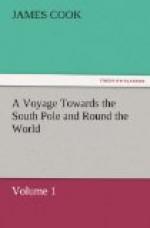The country is exceedingly mountainous, not only about Dusky Bay, but through all the southern part of this western coast of Tavai Poenammoo. A prospect more rude and craggy is rarely to be met with, for inland appears nothing but the summits of mountains of a stupendous height, and consisting of rocks that are totally barren and naked, except where they are covered with snow. But the land bordering on the sea-coast, and all the islands, are thickly clothed with wood, almost down to the water’s edge. The trees are of various kinds, such as are common to other parts of this country, and are fit for the shipwright, house-carpenter, cabinet-maker, and many other uses. Except in the river Thames, I have not seen finer timber in all New Zealand; both here and in that river, the most considerable for size is the Spruce-tree, as we called it, from the similarity of its foliage to the American spruce, though the wood is more ponderous, and bears a greater resemblance to the pitch-pine. Many of these trees are from six to eight and ten feet in girt, and from sixty to eighty or one hundred feet in length, large enough to make a main-mast for a fifty-gun ship.
Here are, as well as in all other parts of New Zealand, a great number of aromatic trees and shrubs, most of the myrtle kind; but amidst all this variety, we met with none which bore fruit fit to eat.
In many parts the woods are so over-run with supplejacks, that it is scarcely possible to force one’s way amongst them. I have seen several which were fifty or sixty fathoms long.
The soil is a deep black mould, evidently composed of decayed vegetables, and so loose that it sinks under you at every step; and this may be the reason why we meet with so many large trees as we do, blown down by the wind, even in the thickest part of the woods. All the ground amongst the trees is covered with moss and fern, of both which there is a great variety; but except the flax or hemp plant, and a few other plants, there is very little herbage of any sort, and none that was eatable, that we found, except about a handful of water-cresses, and about the same quantity of cellery. What Dusky Bay most abounds with is fish: A boat with six or eight men, with hooks and lines, caught daily sufficient to serve the




